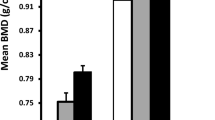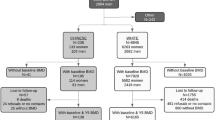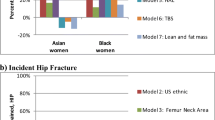Abstract
Summary
Bone mineral density does not explain race/ethnicity differences in hip fracture risk. In this study, we demonstrated that race/ethnicity differences in composite hip strength indices were consistent with documented race/ethnicity differences in hip fracture risk, suggesting that unlike bone density, the composite indices may represent ethnicity-independent measures of bone strength.
Introduction
African–American and Asian women have lower risks of hip fracture than Caucasian women, but such racial/ethnic variation in hip fracture risk cannot be explained by bone mineral density (BMD). The composite indices of femoral neck strength integrate femoral neck and body size with BMD and predict hip fracture risk in Caucasian women. We hypothesize that unlike race/ethnic differences in BMD, race/ethnic differences in the composite strength indices would be consistent with race/ethnic differences in hip fracture risk.
Methods
We studied a community-based sample of Caucasian (n = 968), African–American (n = 512), Chinese (n = 221), and Japanese (n = 239) women, premenopausal or in early perimenopause, from the Study of Women's Health Across the Nation.
Results
Unadjusted indices were similar in Caucasian and African–American women but higher in Asian women. After adjusting for age, body mass index, and menopause status, all three minority groups had higher composite strength indices than Caucasian women. Foreign-born Japanese women had higher unadjusted and adjusted composite strength indices than US-born Japanese women, but such differences by nativity were not observed in Chinese women.
Conclusion
We concluded that composite strength indices have the potential to explain racial/ethnic differences in hip fracture risk, suggesting that composite strength indices may represent ethnicity-independent measures of bone strength. This contention needs to be verified by further research on the fracture predictive ability of composite strength indices in multi-ethnic longitudinal cohorts.

Similar content being viewed by others
References
Ross PD, Norimatsu H, Davis JW, Yano K, Wasnich RD, Fujiwara S, Hosoda Y, Melton LJ 3rd (1991) A comparison of hip fracture incidence among native Japanese, Japanese Americans, and American Caucasians. Am J Epidemiol 133(8):801–809
Lauderdale DS, Jacobsen SJ, Furner SE, Levy PS, Brody JA, Goldberg J (1997) Hip fracture incidence among elderly Asian-American populations. Am J Epidemiol 146(6):502–509
Siris ES, Miller PD, Barrett-Connor E, Faulkner KG, Wehren LE, Abbott TA, Berger ML, Santora AC, Sherwood LM (2001) Identification and fracture outcomes of undiagnosed low bone mineral density in postmenopausal women: results from the National Osteoporosis Risk Assessment. Jama 286(22):2815–2822
Cauley JA, Lui LY, Ensrud KE, Zmuda JM, Stone KL, Hochberg MC, Cummings SR (2005) Bone mineral density and the risk of incident nonspinal fractures in black and white women. Jama 293(17):2102–2108
Robbins J, Aragaki AK, Kooperberg C, Watts N, Wactawski-Wende J, Jackson RD, LeBoff MS, Lewis CE, Chen Z, Stefanick ML, Cauley J (2007) Factors associated with 5-year risk of hip fracture in postmenopausal women. Jama 298(20):2389–2398
Cauley JA, Wu L, Wampler NS, Barnhart JM, Allison M, Chen Z, Jackson R, Robbins J (2007) Clinical risk factors for fractures in multi-ethnic women: the Women's Health Initiative. J Bone Miner Res 22(11):1816–1826
Barrett JA, Baron JA, Karagas MR, Beach ML (1999) Fracture risk in the U.S. Medicare population. J Clin Epidemiol 52(3):243–249
Bouxsein ML, Seeman E (2009) Quantifying the material and structural determinants of bone strength. Best Pract Res Clin Rheumatol 23(6):741–753
Johnell O, Kanis JA, Oden A, Johansson H, De Laet C, Delmas P, Eisman JA, Fujiwara S, Kroger H, Mellstrom D, Meunier PJ, Melton LJ 3rd, O'Neill T, Pols H, Reeve J, Silman A, Tenenhouse A (2005) Predictive value of BMD for hip and other fractures. J Bone Miner Res 20(7):1185–1194
Kanis JA, Oden A, Johnell O, Johansson H, De Laet C, Brown J, Burckhardt P, Cooper C, Christiansen C, Cummings S, Eisman JA, Fujiwara S, Gluer C, Goltzman D, Hans D, Krieg MA, La Croix A, McCloskey E, Mellstrom D, Melton LJ 3rd, Pols H, Reeve J, Sanders K, Schott AM, Silman A, Torgerson D, van Staa T, Watts NB, Yoshimura N (2007) The use of clinical risk factors enhances the performance of BMD in the prediction of hip and osteoporotic fractures in men and women. Osteoporos Int 18(8):1033–1046
Barrett-Connor E, Siris ES, Wehren LE, Miller PD, Abbott TA, Berger ML, Santora AC, Sherwood LM (2005) Osteoporosis and fracture risk in women of different ethnic groups. J Bone Miner Res 20(2):185–194
Cummings SR, Black DM, Nevitt MC, Browner W, Cauley J, Ensrud K, Genant HK, Palermo L, Scott J, Vogt TM (1993) Bone density at various sites for prediction of hip fractures. The Study of Osteoporotic Fractures Research Group. Lancet 341(8837):72–75
Nevitt MC, Johnell O, Black DM, Ensrud K, Genant HK, Cummings SR (1994) Bone mineral density predicts non-spine fractures in very elderly women. Study of Osteoporotic Fractures Research Group. Osteoporos Int 4(6):325–331
Black DM, Cummings SR, Genant HK, Nevitt MC, Palermo L, Browner W (1992) Axial and appendicular bone density predict fractures in older women. J Bone Miner Res 7(6):633–638
De Laet CE, Van Hout BA, Burger H, Weel AE, Hofman A, Pols HA (1998) Hip fracture prediction in elderly men and women: validation in the Rotterdam study. J Bone Miner Res 13(10):1587–1593
Mackey DC, Eby JG, Harris F, Taaffe DR, Cauley JA, Tylavsky FA, Harris TB, Lang TF, Cummings SR (2007) Prediction of clinical non-spine fractures in older black and white men and women with volumetric BMD of the spine and areal BMD of the hip: the Health, Aging, and Body Composition Study*. J Bone Miner Res 22(12):1862–1868
Schott AM, Cormier C, Hans D, Favier F, Hausherr E, Dargent-Molina P, Delmas PD, Ribot C, Sebert JL, Breart G, Meunier PJ (1998) How hip and whole-body bone mineral density predict hip fracture in elderly women: the EPIDOS Prospective Study. Osteoporos Int 8(3):247–254
Stone KL, Seeley DG, Lui LY, Cauley JA, Ensrud K, Browner WS, Nevitt MC, Cummings SR (2003) BMD at multiple sites and risk of fracture of multiple types: long-term results from the Study of Osteoporotic Fractures. J Bone Miner Res 18(11):1947–1954
Taylor BC, Schreiner PJ, Stone KL, Fink HA, Cummings SR, Nevitt MC, Bowman PJ, Ensrud KE (2004) Long-term prediction of incident hip fracture risk in elderly white women: study of osteoporotic fractures. J Am Geriatr Soc 52(9):1479–1486
Fujiwara S, Kasagi F, Masunari N, Naito K, Suzuki G, Fukunaga M (2003) Fracture prediction from bone mineral density in Japanese men and women. J Bone Miner Res 18(8):1547–1553
Yano K, Wasnich RD, Vogel JM, Heilbrun LK (1984) Bone mineral measurements among middle-aged and elderly Japanese residents in Hawaii. Am J Epidemiol 119(5):751–764
Norimatsu H, Mori S, Uesato T, Yoshikawa T, Katsuyama N (1989) Bone mineral density of the spine and proximal femur in normal and osteoporotic subjects in Japan. Bone Miner 5(2):213–222
Nakamura T, Turner CH, Yoshikawa T, Slemenda CW, Peacock M, Burr DB, Mizuno Y, Orimo H, Ouchi Y, Johnston CC Jr (1994) Do variations in hip geometry explain differences in hip fracture risk between Japanese and white Americans? J Bone Miner Res 9(7):1071–1076
Dennison E, Yoshimura N, Hashimoto T, Cooper C (1998) Bone loss in Great Britain and Japan: a comparative longitudinal study. Bone 23(4):379–382
Unnanuntana A, Gladnick BP, Donnelly E, Lane JM (2010) The assessment of fracture risk. J Bone Joint Surg Am 92(3):743–753
Hunt LM, Megyesi MS (2008) Genes, race and research ethics: who's minding the store? J Med Ethics 34(6):495–500
Winker MA (2006) Race and ethnicity in medical research: requirements meet reality. J Law Med Ethics 34(3):520–525, 480
O'Loughlin J (1999) Understanding the role of ethnicity in chronic disease: a challenge for the new millennium. Cmaj 161(2):152–153
Allolio B (1999) Risk factors for hip fracture not related to bone mass and their therapeutic implications. Osteoporos Int 9(Suppl 2):S9–S16
Calis HT, Eryavuz M, Calis M (2004) Comparison of femoral geometry among cases with and without hip fractures. Yonsei Med J 45(5):901–907
Karlsson KM, Sernbo I, Obrant KJ, Redlund-Johnell I, Johnell O (1996) Femoral neck geometry and radiographic signs of osteoporosis as predictors of hip fracture. Bone 18(4):327–330
Karlamangla AS, Barrett-Connor E, Young J, Greendale GA (2004) Hip fracture risk assessment using composite indices of femoral neck strength: the Rancho Bernardo study. Osteoporos Int 15(1):62–70
Finkelstein JS, Brockwell SE, Mehta V, Greendale GA, Sowers MR, Ettinger B, Lo JC, Johnston JM, Cauley JA, Danielson ME, Neer RM (2008) Bone mineral density changes during the menopause transition in a multiethnic cohort of women. J Clin Endocrinol Metab 93(3):861–868
Sowers M, Crawford S, Sternfeld B, Morganstein D, Gold E, Greendale G, Evans D, Neer R, Matthews K, Sherman S, Lo A, Weiss G, Kelsey J (2000) Design, survey, sampling and recruitment methods of SWAN: a multi-center, multi-ethnic, community based cohort study of women and the menopausal transition. Menopause: biology and pathobiology. Academic, San Diego
Lauritzen JB (1997) Hip fractures. Epidemiology, risk factors, falls, energy absorption, hip protectors, and prevention. Dan Med Bull 44(2):155–168
Bouxsein ML, Szulc P, Munoz F, Thrall E, Sornay-Rendu E, Delmas PD (2007) Contribution of trochanteric soft tissues to fall force estimates, the factor of risk, and prediction of hip fracture risk. J Bone Miner Res 22(6):825–831
Thurman DJ, Stevens JA, Rao JK (2008) Practice parameter: assessing patients in a neurology practice for risk of falls (an evidence-based review): report of the Quality Standards Subcommittee of the American Academy of Neurology. Neurology 70(6):473–479
Baecke JA, Burema J, Frijters JE (1982) A short questionnaire for the measurement of habitual physical activity in epidemiological studies. Am J Clin Nutr 36(5):936–942
Waugh EJ, Lam MA, Hawker GA, McGowan J, Papaioannou A, Cheung AM, Hodsman AB, Leslie WD, Siminoski K, Jamal SA (2009) Risk factors for low bone mass in healthy 40–60 year old women: a systematic review of the literature. Osteoporos Int 20(1):1–21
Nomura A, Wasnich RD, Heilbrun LK, Ross PD, Davis JW (1989) Comparison of bone mineral content between Japan-born and US-born Japanese subjects in Hawaii. Bone Miner 6(2):213–223
Lauderdale DS, Kuohung V, Chang SL, Chin MH (2003) Identifying older Chinese immigrants at high risk for osteoporosis. J Gen Intern Med 18(7):508–515
Babbar RK, Handa AB, Lo CM, Guttmacher SJ, Shindledecker R, Chung W, Fong C, Ho-Asjoe H, Chan-Ting R, Dixon LB (2006) Bone health of immigrant Chinese women living in New York City. J Community Health 31(1):7–23
Cooper C, Westlake S, Harvey N, Javaid K, Dennison E, Hanson M (2006) Review: developmental origins of osteoporotic fracture. Osteoporos Int 17(3):337–347
Takahashi K, Juji T, Miyazaki H (1989) Determination of an appropriate size of unrelated donor pool to be registered for HLA-matched bone marrow transplantation. Transfusion 29(4):311–316
Chen J, Zheng H, Bei JX, Sun L, Jia WH, Li T, Zhang F, Seielstad M, Zeng YX, Zhang X, Liu J (2009) Genetic structure of the Han Chinese population revealed by genome-wide SNP variation. Am J Hum Genet 85(6):775–785
Follet H, Boivin G, Rumelhart C, Meunier PJ (2004) The degree of mineralization is a determinant of bone strength: a study on human calcanei. Bone 34(5):783–789
Cauley JA, Danielson ME, Gregg EW, Vogt MT, Zmuda J, Bauer DC (1997) Calcaneal ultrasound attenuation in older African-American and Caucasian-American women. Osteoporos Int 7(2):100–104
Gnudi S, Ripamonti C, Gualtieri G, Malavolta N (1999) Geometry of proximal femur in the prediction of hip fracture in osteoporotic women. Br J Radiol 72(860):729–733
Tsai KS, Cheng WC, Sanchez TV, Chen CK, Chieng PU, Yang RS (1997) Bone densitometry of proximal femur in Chinese subjects: gender differences in bone mass and bone areas. Bone 20(4):365–369
Acknowledgments
The Study of Women's Health Across the Nation (SWAN) has grant support from the National Institutes of Health (NIH), DHHS, through the National Institute on Aging (NIA), the National Institute of Nursing Research (NINR), and the NIH Office of Research on Women's Health (ORWH) (grants NR004061; AG012505, AG012535, AG012531, AG012539, AG012546, AG012553, AG012554, AG012495). Dr. Ishii was supported by VA Greater Los Angeles Healthcare System Geriatric Research, Education and Clinical Center; and VA Advanced Geriatrics Fellowship. The Hip Strength Through the Menopausal Transition has grant support from the NIA (AG026463). The SWAN Hip Strength Sub-Study has grant support from the NIA (AG028748). The content of this article is solely the responsibility of the authors and does not necessarily represent the official views of the NIA, NINR, ORWH, VA or the NIH. We thank the study staff at each of the following sites and all the women who participated in SWAN: Clinical centers: University of Michigan, Ann Arbor—MaryFran Sowers, PI; Massachusetts General Hospital, Boston, MA—Joel Finkelstein, PI 1999–present; Robert Neer, PI 1994–1999; Rush University, Rush University Medical Center, Chicago, IL—Howard Kravitz, PI 2009–present; Lynda Powell, PI 1994–2009; University of California, Davis/Kaiser—Ellen Gold, PI; University of California, Los Angeles—Gail Greendale, PI; Albert Einstein College of Medicine, Bronx, NY—Rachel Wildman, PI 2010; Nanette Santoro, PI 2004–2010; University of Medicine and Dentistry–New Jersey Medical School, Newark—Gerson Weiss, PI 1994–2004; and the University of Pittsburgh, Pittsburgh, PA—Karen Matthews, PI. NIH program office: National Institute on Aging, Bethesda, MD—Sherry Sherman 1994–present, Marcia Ory 1994–2001; National Institute of Nursing Research, Bethesda, MD–Program Officers. Central laboratory: University of Michigan, Ann Arbor—Daniel McConnell (Central Ligand Assay Satellite Services). Coordinating center: University of Pittsburgh, Pittsburgh, PA—Kim Sutton-Tyrrell, PI 2001–present; New England Research Institutes, Watertown, MA—Sonja McKinlay, PI 1995–2001. Steering committee: Susan Johnson, Current Chair; Chris Gallagher, Former Chair.
Conflicts of interest
None.
Author information
Authors and Affiliations
Corresponding author
Additional information
An erratum to this article can be found at http://dx.doi.org/10.1007/s00198-011-1887-4.
Rights and permissions
About this article
Cite this article
Ishii, S., Cauley, J.A., Greendale, G.A. et al. Ethnic differences in composite indices of femoral neck strength. Osteoporos Int 23, 1381–1390 (2012). https://doi.org/10.1007/s00198-011-1723-x
Received:
Accepted:
Published:
Issue Date:
DOI: https://doi.org/10.1007/s00198-011-1723-x




